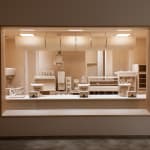Roxy Paine USA, b. 1966
Carcass - Diorama, 2013
Birch, maple, glass, fluorescent
Approx. 13.9 x 20.04 x 13.5 ft
4.2 x 6.1 x 4.1 m
4.2 x 6.1 x 4.1 m
3703
Further images
-
(View a larger image of thumbnail 1
)

-
(View a larger image of thumbnail 2
)

-
(View a larger image of thumbnail 3
)

-
(View a larger image of thumbnail 4
)

-
(View a larger image of thumbnail 5
)

-
(View a larger image of thumbnail 6
)

-
(View a larger image of thumbnail 7
)

-
(View a larger image of thumbnail 8
)

-
(View a larger image of thumbnail 9
)

-
(View a larger image of thumbnail 10
)

-
(View a larger image of thumbnail 11
)

-
(View a larger image of thumbnail 12
)

-
(View a larger image of thumbnail 13
)

-
(View a larger image of thumbnail 14
)

-
(View a larger image of thumbnail 15
)

-
(View a larger image of thumbnail 16
)

-
(View a larger image of thumbnail 17
)

-
(View a larger image of thumbnail 18
)

-
(View a larger image of thumbnail 19
)

-
(View a larger image of thumbnail 20
)

-
(View a larger image of thumbnail 21
)

-
(View a larger image of thumbnail 22
)

-
(View a larger image of thumbnail 23
)

-
(View a larger image of thumbnail 24
)

-
(View a larger image of thumbnail 25
)

-
(View a larger image of thumbnail 26
)

Moving away from his hyperreal resin sculptures and the perfect industrial sheen of his signature 'Dendroid' series (life sized trees rendered in stainless steel), Roxy Paine's exploration of dioramas began...
Moving away from his hyperreal resin sculptures and the perfect industrial sheen of his signature "Dendroid" series (life sized trees rendered in stainless steel), Roxy Paine's exploration of dioramas began the artist's new focus on wood as a medium. Looking at the machined, synthetic interiors of contemporary America, the warm wood dioramas give us pause to consider the most iconic, emblematic spaces with live with today. Beginning with his landmark exhibition Apparatus at Kavi Gupta in Chicago, which won the International Art Critics Association (AICA-USA) award for best commercial gallery show in the country, Paine set his sights on the abstract concepts of a "control room" and a "fast food restaurant" as subjects for meditation. Reproduced at 1:1 scale, the dioramas are not merely models, but highly illusory viewing rooms onto a static portrait of a spatial moment.
In Carcass, we see a fast food counter, kitchen, and back room lovingly and carefully rendered in wood. A wood post-in note on the wall carries no text, and a wood fryer basket holds no food. The exact moment when this space would have exist is ambiguous. A CRT television monitor perhaps indicates something before the turn of the millennium, but the overall aesthetics speak to a kind of cultural plateau, an unchanging generality that isn't identifiable even to a brand, just broadly, "a fast food restaurant." The title—Carcass—perhaps most plainly signals how the diorama is not simply inert, but is meant to accurately capture this inertness: this kind of space is dead, it is not growing or changing with the times.
In Carcass, we see a fast food counter, kitchen, and back room lovingly and carefully rendered in wood. A wood post-in note on the wall carries no text, and a wood fryer basket holds no food. The exact moment when this space would have exist is ambiguous. A CRT television monitor perhaps indicates something before the turn of the millennium, but the overall aesthetics speak to a kind of cultural plateau, an unchanging generality that isn't identifiable even to a brand, just broadly, "a fast food restaurant." The title—Carcass—perhaps most plainly signals how the diorama is not simply inert, but is meant to accurately capture this inertness: this kind of space is dead, it is not growing or changing with the times.
Provenance
The artist's studio, New York, NY, USAKavi Gupta gallery, Chicago, IL, USA
Exhibitions
Roxy Paine, Apparatus, 2013, Kavi Gupta, Chicago, IL, USARoxy Paine, Serotonin Reuptake Inhibitor, 2016, Beeler Gallery, CCAD, Columbus, OH, USA

























